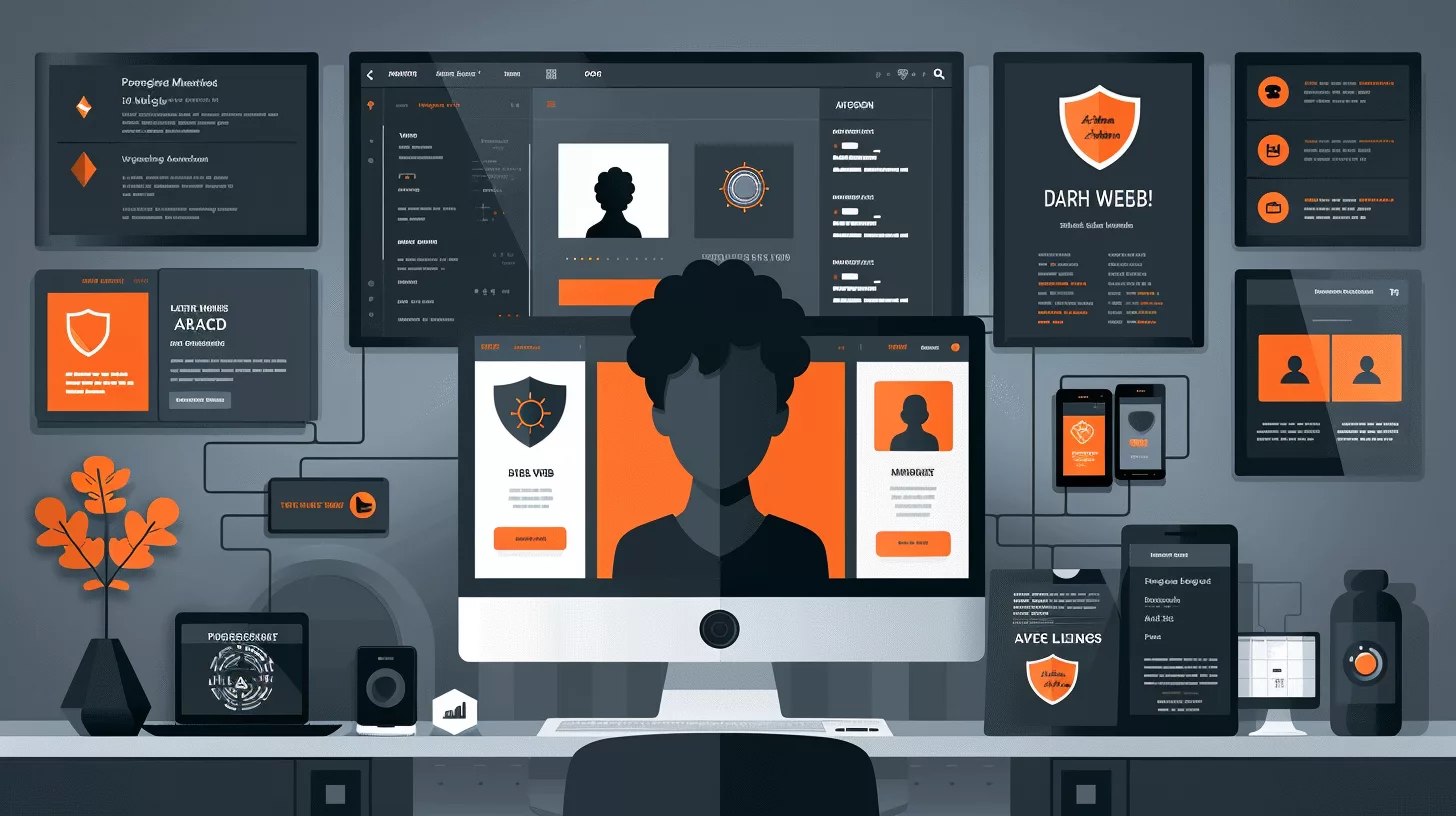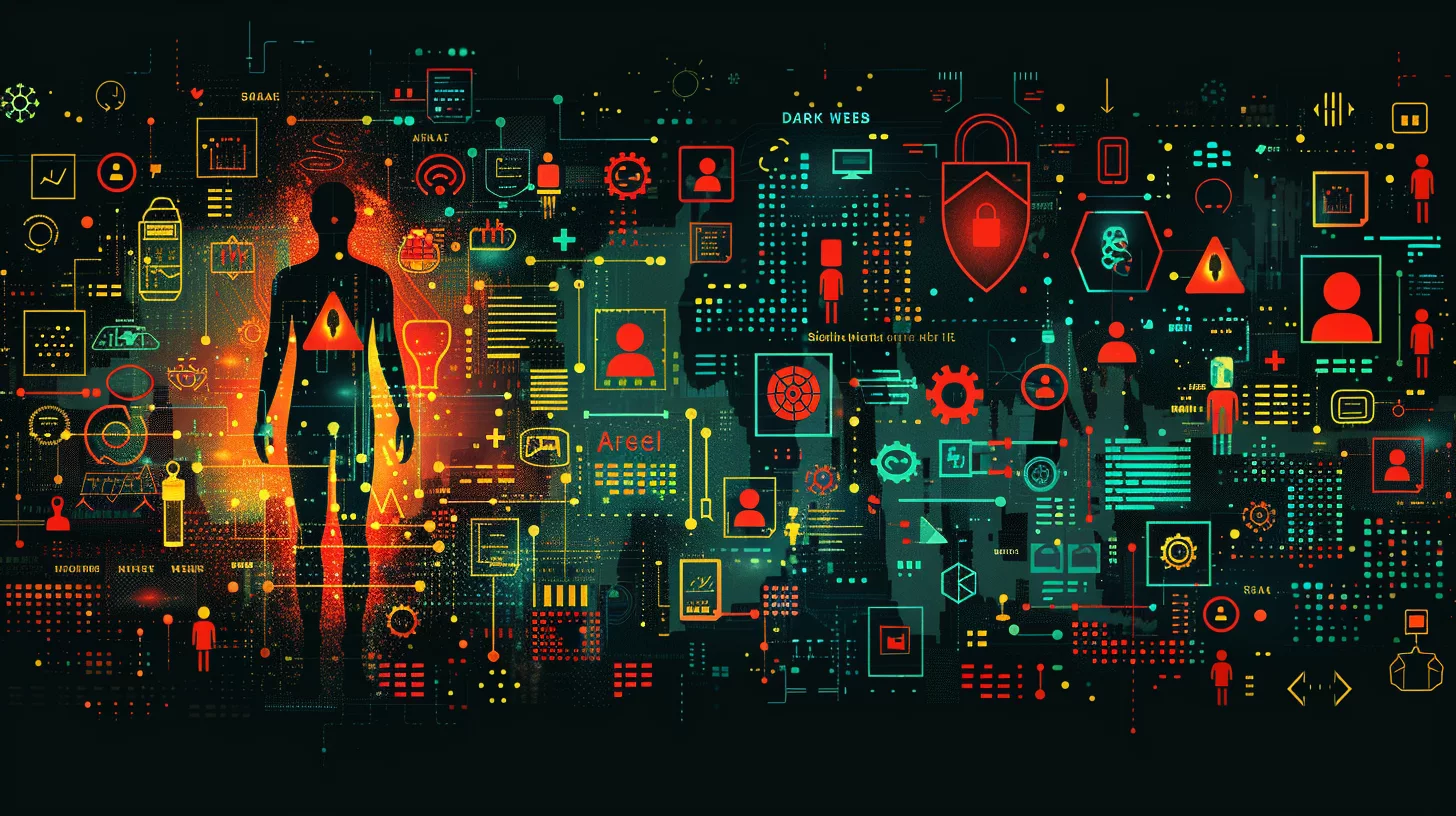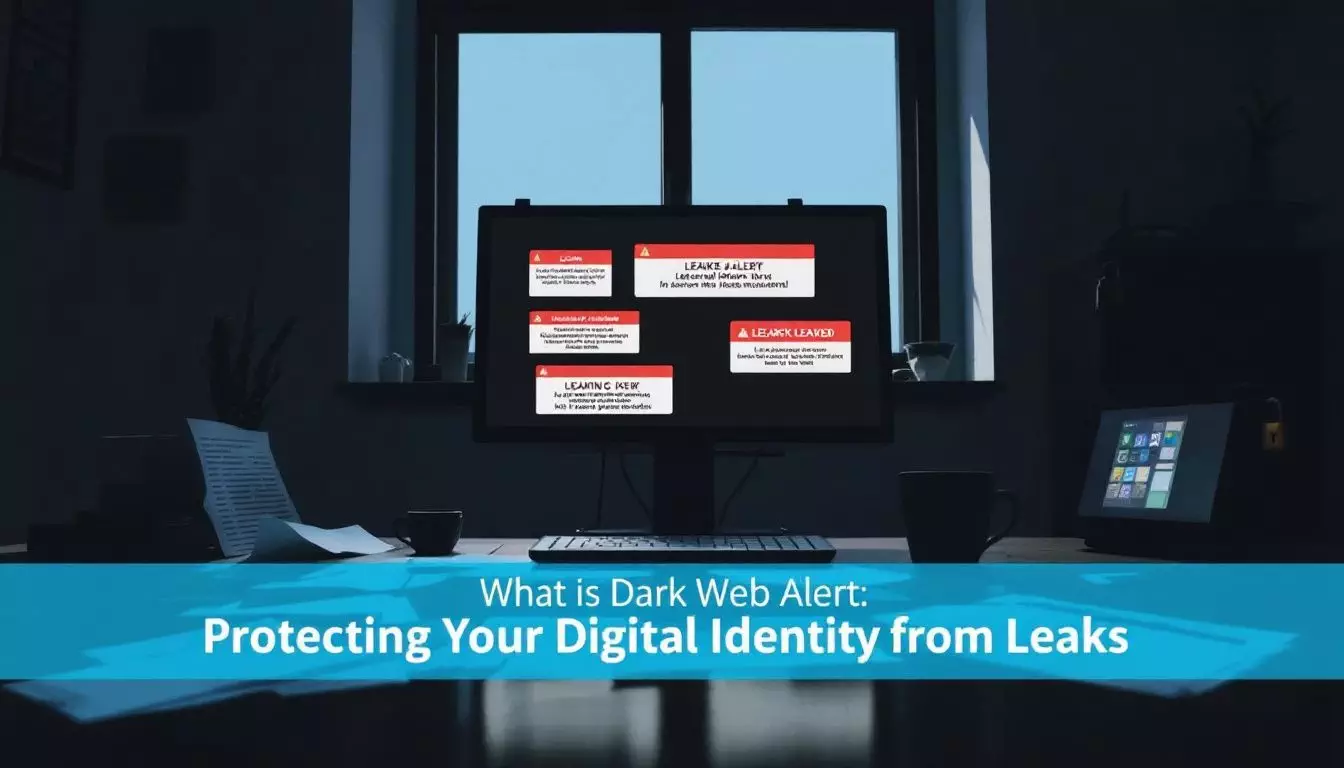Dark web alerts protect your digital identity from cyber threats. These notifications inform users when their personal data appears on hidden online marketplaces. Over 15 billion stolen credentials circulate on the dark web, putting countless individuals at risk of identity theft and financial fraud. 3
Dark web alerts play a crucial role in modern cybersecurity practices. They help users take quick action to secure compromised accounts. 1
Key Takeaways
- Dark web alerts scan hidden sites for leaked personal info like passwords and credit card numbers.
- Over 15 billion stolen credentials are on the dark web, putting many at risk of identity theft.
- Quick action after an alert includes changing passwords, freezing credit, and checking bank statements.
- New tech like anonymizing browsers can help protect user privacy while navigating online threats.
- AI and blockchain help spot dark web threats faster.
- Using strong passwords, two-factor login, and regular updates helps stay safe from cyber risks.
Understanding Dark Web Alert: A Cybersecurity Essential

Dark Web Alerts are key tools in today’s online safety kit. They scan hidden corners of the internet for your personal info, keeping you one step ahead of cyber crooks.
What is a Dark Web Alert and How Does It Work?
Dark web alerts notify users when their personal info shows up on hidden sites. These alerts stem from automated scans of numerous dark web pages. 1
Specialized services check for leaked data like passwords, credit cards, and Social Security numbers. They compare findings against a user’s protected details.
Users get instant notifications if their info appears. This quick action lets people secure accounts before criminals can use the data.
The Importance of Dark Web Monitoring for Personal Information
Dark web monitoring plays a crucial role in safeguarding personal data. It scans hidden websites for leaked information, alerting users if their data appears. 2 This service acts as an early warning system against identity theft and fraud.
Companies often fall victim to data breaches, exposing customer details to criminals. Monitoring helps catch these leaks fast, giving people time to act.
Dark web monitoring is like a digital smoke alarm for your personal information.
Personal info on the dark web can lead to serious problems. Thieves use stolen data to open fake accounts, make purchases, or even commit crimes in someone else’s name. Regular scans catch issues early, letting users change passwords or freeze credit reports.
This quick action can prevent major headaches and financial losses. Dark web alerts give people power over their digital identity in an age of constant cyber threats.
Risks of Your Information Ending Up on the Dark Web
Personal info on the dark web puts you at risk. Cybercriminals buy and sell stolen data there. Names, addresses, phone numbers, and Social Security numbers often end up for sale. 3 Credit card details and login credentials are hot items too.
Data breaches and phishing scams fuel this black market. Malware attacks also grab sensitive info. A dark web alert means your data is out there – ready for crooks to exploit. They could open fake accounts, make purchases, or steal your identity. Protecting yourself starts with knowing the dangers.
How Dark Web Monitor Tools Protect Your Digital Identity

Dark Web Monitor Tools act as digital guardians. They scan the hidden corners of the internet to spot your personal info before it’s misused.
Features of Effective Dark Web Monitor Solutions
Effective Dark Web Monitor Solutions pack powerful features to shield your digital identity. These tools work tirelessly to spot risks and keep you safe online. 4
- Real-time alerts: Instant notifications when personal info appears on dark web sites
- Broad coverage: Scans millions of sites, forums, and marketplaces 24/7
- Data breach detection: Flags compromised accounts from third-party leaks
- Brand protection: Spots misuse of company names or trademarks
- Credential monitoring: Tracks leaked passwords and login details
- Social media scanning: Checks for impersonation attempts on platforms
- Customizable alerts: Lets users set specific triggers for notifications
- Integration options: Links with other security tools for a unified defense
- User-friendly dashboard: Offers clear risk overviews and action steps
- Remediation guidance: Provides steps to secure compromised accounts. 5
Types of Information Found on the Dark Web
Dark web monitors scan for various types of sensitive data. These tools search for personal information that could be used for identity theft or financial fraud.
- Passwords: Compromised login credentials for email, social media, and other online accounts.
- Social Security numbers: Full or partial SSNs linked to individuals.
- Credit card details: Card numbers, expiration dates, and CVV codes.
- Bank account info: Account and routing numbers for financial accounts.
- Medical records: Health insurance details and patient data.
- Driver’s license numbers: State-issued ID information.
- Passport data: Passport numbers and other travel document details.
- Home addresses: Current and past residential information.
- Phone numbers: Mobile and landline contact details.
- Email addresses: Personal and work email accounts.
- Date of birth: Full birthdates of individuals.
- Employment info: Company names, job titles, and work history.
Benefits of Continuous Dark Web Monitoring
Continuous dark web monitoring offers round-the-clock protection for digital identities. It scans billions of web pages to spot leaked passwords and sensitive data fast. Users get quick alerts if their info pops up on shady sites. This lets them act fast to change passwords and secure accounts. 6
Dark web alerts help stop identity theft before it starts. They catch breaches early, giving users time to protect themselves. The next section explains how to respond when an alert hits your inbox.
Responding to a Dark Web Alert: Steps to Secure Your Data

When a Dark Web Alert hits, quick action is key. Learn the steps to lock down your data and stay safe online. Read on to find out how to protect yourself from cyber threats.
Immediate Actions When Your Information is on the Dark Web
Dark web alerts can be scary. Here’s what to do right away if your info shows up there:
- Change passwords fast. Make new ones strong and unique for each account.
- Turn on two-factor authentication. This adds an extra layer of security to your logins.
- Freeze your credit reports. Contact Experian, TransUnion, and Equifax to stop new accounts. 7
- Check your bank statements. Look for odd charges or withdrawals you didn’t make.
- Set up fraud alerts. Tell your bank and credit card companies to watch for weird activity.
- Update your security questions. Pick new ones that others can’t guess easily.
- Scan your devices. Run anti-virus software to catch any hidden malware.
- Close unused accounts. Get rid of old profiles you don’t need anymore.
- Monitor your credit score. Keep an eye out for sudden drops or changes.
- Use a password manager. It helps create and store complex passwords safely.
Long-term Strategies to Prevent Future Data Leaks
Secure password managers provide effective protection against data breaches. These tools generate and maintain unique, intricate passwords for each account. Users need to recall only one primary password. This strategy prevents unauthorized access to multiple accounts if a single password is compromised. 8
Consistent security updates are crucial for ongoing data protection. Software patches address known vulnerabilities. Activating automatic updates on devices and applications maintains system security.
Two-factor authentication incorporates an additional layer of protection. It necessitates a second form of verification, such as a fingerprint or a code sent to a mobile device. This approach increases the difficulty for unauthorized users to access accounts, even if they possess the password.
Working with Cybersecurity Experts to Mitigate Risks
Cybersecurity experts offer vital help in protecting digital identities. They scan the dark web for leaked info and guide users on best practices. 9
Bitdefender Digital Identity Protection, for example, searches the dark web for exposed personal data. These pros tailor their advice to specific regions, ensuring local relevance.
Expert guidance often includes video tutorials. These show users how to take action and safeguard their data. With pro help, people learn to use tools like VPNs and password managers.
Experts also teach about multi-factor authentication and credit monitoring. Their knowledge helps users stay ahead of cyber threats.
Dark Web Alert vs. Other Cybersecurity Measures

Dark Web Alerts offer a unique edge in digital safety. They scan hidden corners of the internet that other tools can’t reach.
Comparing Dark Web Alerts to Traditional Security Methods
Dark web alerts offer a proactive approach to digital security. Traditional methods often fall short in today’s complex threat landscape.
| Dark Web Alerts | Traditional Security Methods |
|---|---|
| Detect compromised info quickly | React after a breach occurs |
| Monitor dark web continuously | Focus on perimeter defense |
| Provide real-time notifications | Rely on periodic scans |
| Identify specific stolen credentials | Offer general threat protection |
| Enable fast response to threats | Average 194 days to ID breaches |
Alex Herrick and Joshua Correos know the value of dark web alerts. Their Web Design Booth team uses these tools to protect client data. Dark web monitoring catches threats traditional methods miss. 4 It spots leaked passwords and account info fast. This speed lets users act before criminals exploit their data.
Integrating Dark Web Monitoring into Your Overall Digital Security Plan
Dark web monitoring forms a key part of a solid digital security plan. It scans hidden corners of the internet for leaked data. Users get alerts if their info pops up on shady sites.
This lets them act fast to change passwords and lock accounts. Smart folks pair dark web checks with other safety steps. They use strong, unique passwords for each account. They turn on two-factor login everywhere possible.
Regular software updates and anti-virus programs add more layers of defense. A complete security approach mixes proactive and reactive measures. It keeps personal data safer from cyber crooks.
The Role of Dark Web Alerts in Modern Cybersecurity Practices
Dark web alerts play a key role in modern cybersecurity. These tools scan hidden parts of the internet for leaked data. They quickly spot stolen passwords or breached accounts. This helps companies act fast to stop hackers.
Effective dark web alerts give businesses an edge against cyber threats. They cut down the time between a data leak and its discovery. This lets firms patch security holes faster. Dark web monitoring also helps track stolen intellectual property.
It’s a vital part of a complete digital security plan. For creative pros and tech fans, these alerts offer peace of mind about personal data safety online.
The Future of Dark Web Alerts and Digital Identity Protection

Dark web alerts are getting smarter. New tech will spot threats faster and keep your info safer.
Emerging Technologies in Dark Web Monitoring
New tech is changing how we watch the dark web. These tools help catch bad guys faster and keep our info safer.
- AI-powered scanners: Smart programs now search the dark web 24/7. They spot stolen data quickly using machine learning.
- Blockchain tracking: Special software follows crypto payments on the dark web. This helps find criminals who use digital money.
- Advanced data mining: Better tools dig deep into dark web forums and markets. They find hidden clues about new cyber threats.
- Real-time alerts: Systems now warn users right away if their info shows up online. This lets people act fast to protect themselves.
- Threat intelligence sharing: Companies team up to share what they learn about the dark web. This helps everyone stay safer.
- Natural language processing: Computers can now understand slang and code words used on the dark web. This cracks secret messages.
- Automated risk scoring: New tech ranks how bad a dark web threat is. This helps teams focus on the worst problems first.
- Deep learning networks: Super smart AI learns to spot new types of dark web dangers. It gets better at finding threats over time.
Predicted Trends in Cybersecurity and Dark Web Threats
As dark web monitoring evolves, cybersecurity threats continue to grow. Experts predict several trends in this digital battleground:
- AI-powered attacks: Hackers will use artificial intelligence to create more sophisticated phishing emails and malware.
- Ransomware evolution: Cybercriminals will target cloud services and IoT devices with advanced ransomware strains.
- Supply chain attacks: Bad actors will exploit vulnerabilities in third-party software and services to breach multiple organizations.
- Deepfake scams: Criminals will use AI-generated audio and video to trick people into revealing sensitive information.
- Cryptocurrency-based crimes: The dark web will see a rise in crypto-related fraud and money laundering schemes.
- Mobile malware surge: Hackers will focus on exploiting vulnerabilities in smartphone apps and operating systems.
- IoT botnet attacks: Cybercriminals will hijack unsecured smart devices to launch large-scale DDoS attacks.
- Data poisoning: Attackers will manipulate training data for AI systems, compromising their accuracy and reliability.
- Quantum computing threats: As quantum computers advance, they may crack current encryption methods, exposing sensitive data.
- Social engineering tactics: Criminals will use more sophisticated psychological manipulation techniques to gain access to systems.
How Individuals and Businesses Can Stay Ahead of Dark Web Risks
Predicted trends point to more sophisticated cyber threats. Individuals and businesses must stay vigilant. They can protect themselves with proactive steps. Using strong, unique passwords for each account is crucial.
A password manager is like a special safe for your passwords. It helps you make strong, unique passwords for each of your accounts. Two-factor authentication is like adding a second lock to your door. It makes it even harder for bad guys to get in.
Dark web monitoring services scan for leaked data continuously. These tools alert users if their info appears on illegal marketplaces. Credit monitoring catches suspicious activity early.
Freezing credit reports prevents new accounts from being opened. Employee training on phishing and social engineering tactics boosts overall security. Backing up data regularly protects against ransomware attacks. Encryption safeguards sensitive files both in transit and at rest.
Conclusion
Dark web alerts guard your digital life. They spot leaked info fast. Users must act quick to change passwords and lock accounts. Smart folks use these alerts with other security tools.
Stay safe online – protect your data now.
FAQs
1. What’s a dark web alert?
It’s a warning about your info on hidden sites. These alerts spy on secret places online where bad guys trade stolen data. They tell you if your stuff is out there.
2. How can I protect my digital identity?
Use strong passwords. Try a password maker. Turn on 2-step login. Watch your credit. Freeze it if needed. Use good internet tools. Be careful what you share online.
3. What should I do if I get a dark web alert?
First, don’t panic. Change your passwords fast. Check your bank and credit card accounts. Tell your bank. Watch for weird stuff. Maybe freeze your credit.
4. Are dark web alerts part of identity theft protection?
Yes! Good protection plans include dark web checks. They look for your info in bad places. They also watch your credit and help if someone steals your identity.
5. Can regular people access the dark web?
Kinda. You need special software. But it’s risky. Bad guys hang out there. It’s best to stay away unless you really know what you’re doing.
6. How often should I check for dark web leaks?
All the time is best. Good protection services do this for you. They keep an eye out 24/7. If they find something, they tell you right away.
References
- ^ https://arctiq.com/blog/unseen-threats-the-crucial-role-of-dark-web-monitoring-in-cybersecurity
- ^ https://support.norton.com/sp/en/us/home/current/solutions/v127344370
- ^ https://www.forbes.com/sites/daveywinder/2020/07/08/new-dark-web-audit-reveals-15-billion-stolen-logins-from-100000-breaches-passwords-hackers-cybercrime/
- ^ https://www.crowdstrike.com/en-us/cybersecurity-101/threat-intelligence/dark-web-monitoring/ (2023-04-27)
- ^ https://www.fortinet.com/resources/cyberglossary/dark-web-monitoring
- ^ https://www.upguard.com/blog/dark-web-monitoring
- ^ https://www.experian.com/blogs/ask-experian/what-to-do-if-information-is-found-on-dark-web/ (2022-05-12)
- ^ https://www.idwatchdog.com/information-found-on-dark-web
- ^ https://www.kaspersky.com/resource-center/threats/what-is-a-dark-web-scan

